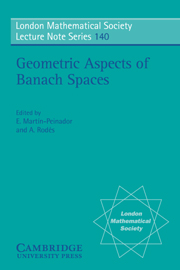Book contents
- Frontmatter
- Contents
- Dedication
- 1 Antonio Plans: a biographical outline
- 2 Infinite dimensional geometric moduli and type-cotype theory
- 3 Hilbert space revisited
- 4 Particular M-basic sequences in Banach spaces
- 5 Behaviour of semi-Fredholm operators on a Hilbert cube
- 6 Operators from H1 into a Banach space and vector valued measures
- 7 Operators on vector sequence spaces
- 8 On the duality problem for entropy numbers
- 9 Mixed summing norms and finite dimensional Lorentz spaces
- 10 On the extension of 2-polynomials in normed linear spaces
- 11 On some operator ideals defined by approximation numbers
- 12 Some remarks on the compact non-nuclear operator problem
- 13 On some properties of A*, L1/H10 as Banach Algebras
- 14 On factorization of operators
- 15 Some properties of Banach spaces Z**/Z
9 - Mixed summing norms and finite dimensional Lorentz spaces
Published online by Cambridge University Press: 04 August 2010
- Frontmatter
- Contents
- Dedication
- 1 Antonio Plans: a biographical outline
- 2 Infinite dimensional geometric moduli and type-cotype theory
- 3 Hilbert space revisited
- 4 Particular M-basic sequences in Banach spaces
- 5 Behaviour of semi-Fredholm operators on a Hilbert cube
- 6 Operators from H1 into a Banach space and vector valued measures
- 7 Operators on vector sequence spaces
- 8 On the duality problem for entropy numbers
- 9 Mixed summing norms and finite dimensional Lorentz spaces
- 10 On the extension of 2-polynomials in normed linear spaces
- 11 On some operator ideals defined by approximation numbers
- 12 Some remarks on the compact non-nuclear operator problem
- 13 On some properties of A*, L1/H10 as Banach Algebras
- 14 On factorization of operators
- 15 Some properties of Banach spaces Z**/Z
Summary
INTRODUCTION
This largely expository article describes some recent results concerning the mixed summing norm Πp, 1 as applied to operators on ℓ∞-spaces (especially the finite-dimensional spaces). The whole subject of summing operators and their norms can be said to have started with a result on Π2, 1 – the theorem of Orlicz (1933) that the identity operators in ℓ2 and ℓ1 are (2, 1)-summing. However, since that time the study of mixed summing norms has been somewhat neglected in favour of the elegant and powerful theory of the “unmixed” summing norms Πlp. A breakthrough hasnow been provided by the theorem of Pisier, which does for mixed summing norms what the fundamental theorem of Pietsch does for unmixed ones (see e.g.). One version of Pisier's theorem states that the operator can be factorised through a Lorentz function space Lp, 1 (λ). Such spaces were introduced in, and are discussed in and. However, it is not easy to find a really simple outline of the definition and basic properties of these spaces adapted to the (obviously simpler) finite-dimensional case, so the present paper includes a brief attempt to provide one.
It is of particular interest to compare the value of Π2, 1 and Π2 for operators on ℓ∞ or. It is a well-known fact, underlying the famous Grothendieck inequality, that there is a constant K, independent of n, such that for all operators T from to ℓ1 or ℓ2, we have Π2 (T)≤ K∥T∥. This equates to saying that Π2 (T) s K'Π2, 1 (T) for such T.
Information
- Type
- Chapter
- Information
- Geometric Aspects of Banach SpacesEssays in Honour of Antonio Plans, pp. 112 - 124Publisher: Cambridge University PressPrint publication year: 1989
Accessibility standard: Unknown
Why this information is here
This section outlines the accessibility features of this content - including support for screen readers, full keyboard navigation and high-contrast display options. This may not be relevant for you.Accessibility Information
- 1
- Cited by
